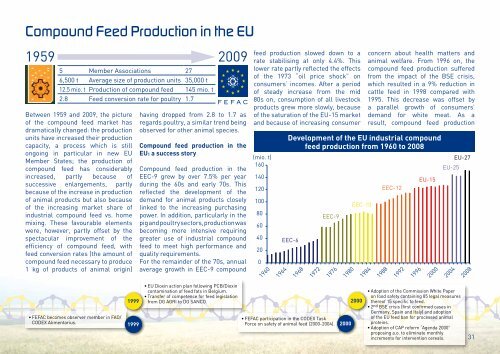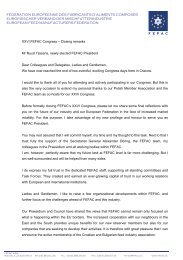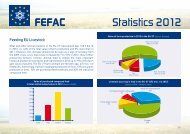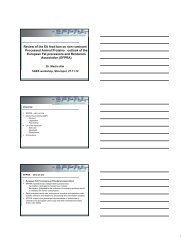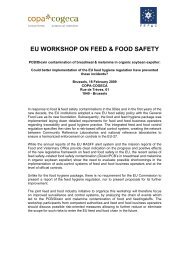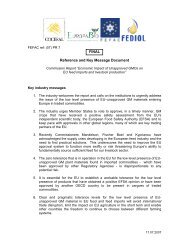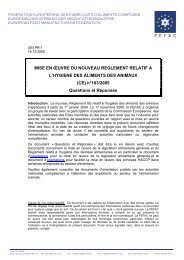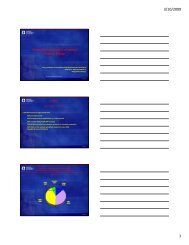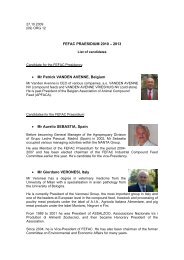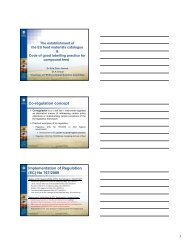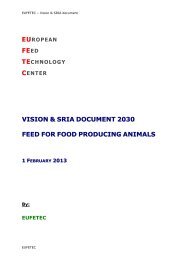Brochure (PDF) - Fefac
Brochure (PDF) - Fefac
Brochure (PDF) - Fefac
Create successful ePaper yourself
Turn your PDF publications into a flip-book with our unique Google optimized e-Paper software.
Compound Feed Production in the EU<br />
1959 2009<br />
5 Member Associations 27<br />
6,500 t Average size of production units 35,000 t<br />
12.5 mio. t Production of compound feed 145 mio. t<br />
2.8 Feed conversion rate for poultry 1.7<br />
Between 1959 and 2009, the picture<br />
of the compound feed market has<br />
dramatically changed: the production<br />
units have increased their production<br />
capacity, a process which is still<br />
ongoing in particular in new EU<br />
Member States; the production of<br />
compound feed has considerably<br />
increased, partly because of<br />
successive enlargements, partly<br />
because of the increase in production<br />
of animal products but also because<br />
of the increasing market share of<br />
industrial compound feed vs. home<br />
mixing. These favourable elements<br />
were, however, partly offset by the<br />
spectacular improvement of the<br />
efficiency of compound feed, with<br />
feed conversion rates (the amount of<br />
compound feed necessary to produce<br />
1 kg of products of animal origin)<br />
1999<br />
• FEFAC becomes observer member in FAO/<br />
CODEX Alimentarius. 1999<br />
having dropped from 2.8 to 1.7 as<br />
regards poultry, a similar trend being<br />
observed for other animal species.<br />
Compound feed production in the<br />
EU: a success story<br />
Compound feed production in the<br />
EEC-9 grew by over 7.5% per year<br />
during the 60s and early 70s. This<br />
reflected the development of the<br />
demand for animal products closely<br />
linked to the increasing purchasing<br />
power. In addition, particularly in the<br />
pig and poultry sectors, production was<br />
becoming more intensive requiring<br />
greater use of industrial compound<br />
feed to meet high performance and<br />
quality requirements.<br />
For the remainder of the 70s, annual<br />
average growth in EEC-9 compound<br />
• EU Dioxin action plan following PCB/Dioxin<br />
contamination of feed fats in Belgium.<br />
• Transfer of competence for feed legislation<br />
from DG AGRI to DG SANCO.<br />
feed production slowed down to a<br />
rate stabilising at only 4.4%. This<br />
lower rate partly reflected the effects<br />
of the 1973 “oil price shock” on<br />
consumers’ incomes. After a period<br />
of steady increase from the mid<br />
80s on, consumption of all livestock<br />
products grew more slowly, because<br />
of the saturation of the EU-15 market<br />
and because of increasing consumer<br />
(mio. t)<br />
160<br />
140<br />
120<br />
100<br />
80<br />
60<br />
40<br />
20<br />
0<br />
1960<br />
concern about health matters and<br />
animal welfare. From 1996 on, the<br />
compound feed production suffered<br />
from the impact of the BSE crisis,<br />
which resulted in a 9% reduction in<br />
cattle feed in 1998 compared with<br />
1995. This decrease was offset by<br />
a parallel growth of consumers’<br />
demand for white meat. As a<br />
result, compound feed production<br />
Development of the EU industrial compound<br />
feed production from 1960 to 2008<br />
EEC-6<br />
1964<br />
1968<br />
1972<br />
EEC-9<br />
1976<br />
1980<br />
• FEFAC participation in the CODEX Task<br />
Force on safety of animal feed (2000-2004). 2000<br />
EEC-10<br />
2000<br />
1984<br />
EEC-12<br />
1988<br />
1992<br />
1996<br />
EU-15<br />
2000<br />
EU-25<br />
2004<br />
• Adoption of the Commission White Paper<br />
on food safety containing 85 legal measures<br />
thereof 15 specific to feed.<br />
• 2 nd BSE crisis (first confirmed cases in<br />
Germany, Spain and Italy) and adoption<br />
of the EU feed ban for processed animal<br />
proteins.<br />
• Adoption of CAP reform “Agenda 2000”<br />
proposing a.o. to eliminate monthly<br />
increments for intervention cereals.<br />
EU-27<br />
2008<br />
31


